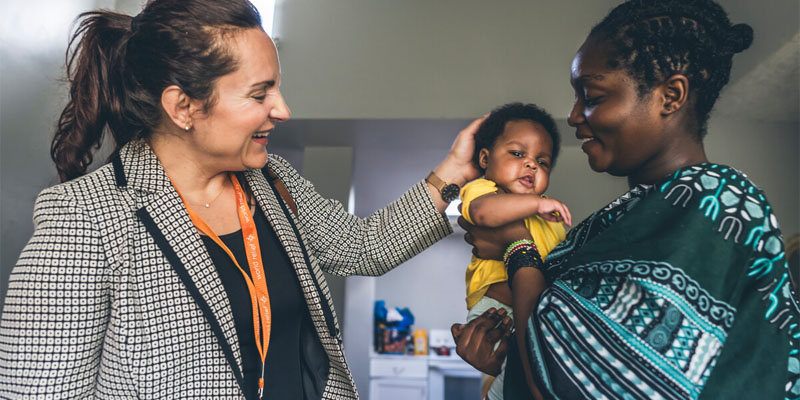In the Path of the Storm
It was late May in 2004 when torrential rains hit Mapou, a small village nestled within the La Selle mountain range in southeastern Haiti. This nameless storm dumped water on Mapou for three consecutive days, killing over 432 people in Mapou and another 800 in other villages throughout Haiti. Mapou, among several other villages, was left under a lake of water, and more than 31,000 people across Haiti were left without homes.
Nicole Eliassaint, a local resident in Mapou, recalled the terror that consumed her village.
“No one could go out to see their relatives or ask for information,” she said. “We faced a situation of helplessness… some of us had to cling to trees or stay on our roofs for days to avoid being swept away by the waves.”
The storm hit outside the regular storm season, the devastation highlighting how vulnerable Haiti is to natural disasters. The country sits in the middle of an aggressive pathway for tropical storms and hurricanes and also straddles a major faultline. Geography, however, isn’t the only factor that has left Haiti vulnerable to natural disasters.
A Complex History
In 1804, Haiti proudly became the first black republic in history after a successful, slave-led revolution. The war for independence, unfortunately, also destroyed many Haitian plantations, leaving the economy in a fragile state. As a result, Haitian leaders were forced to purchase the recognition of Haiti as a legitimate sovereign nation. In exchange for access to trade markets, they took on massive debt, further crippling the nation’s economy and leaving it prone to political hardship throughout the mid-20th century. This storied history of exploitation and corruption has left the country with a feeble infrastructure and weak economy, making it difficult for Haiti to rebuild the foundation needed to defend against disasters.
Consequently, Haiti has remained locked in a cycle of unhealthy dependence on foreign aid each time disaster strikes. Even with these aid efforts, international relief often struggles to reach the remote areas like Mapou, and little to no system has been developed for warning residents of coming storms.
In 2016, many communities, including Mapou, were still recovering from previous storms when Hurricane Matthew hit. The storm killed 546 people and caused $2.8 billion in destruction. Farms and livestock were destroyed, leaving many Haitians without a source for food or an income.
Catalyst for Change
In his book, The Upside of Down, author Thomas Homer Dixon writes that even the worst catastrophes can be a catalyst for change.
“Catastrophe,” he says, “can create space for [the kind of] creativity that helps build a better world for our children [and] our grandchildren…”
“Breakdown,” he adds, “can shatter the forces standing in the way of change.”
Such is the case when disasters strike, leaving gaping holes in the vulnerable communities that endure them. Buildings crumble, lives are lost and a deep chasm is left in the foundation of the affected society. But what if, as Dixon writes, this catastrophe could make way for creativity that leads to change, and what if this change could be generated by the local church?
Dixon’s words truly come to life in the example of the church in Haiti. In the wake of Hurricane Matthew, church leaders in the Sud, Grand Anse and Nippes regions came together with World Relief to bring aid to people in their communities. Initially, each pastor involved thought they were coming to World Relief to receive food and aid only for themselves, their families and their church members. But after attending a World Relief training, they began to see the bigger picture of what God was calling them to — to come together as a whole church in order to serve the most vulnerable people impacted by the storm.
Church leaders were trained on how to identify problems, mobilize volunteers, write proposals and submit requests for aid. After their requests were approved, churches in Haiti came together with more frequency than ever before, and through their collective efforts, more than 6,000 people received immediate aid in the form of food, water and sanitation supplies. Thousands more received seeds, farming equipment and thorough agriculture training to rebuild their farms and restore their livelihoods. While World Relief Haiti provided the resources for this project, church leaders were co-managers of the project, ensuring equitable distribution as well as a number of volunteers who made the scaling of the project possible.
Local Solutions
In Mapou, World Relief worked alongside church leaders from Bell-Anse, which included pastors from more than 75 churches in the Pichon & Mapou villages. The group came together to brainstorm ways to build resilience and better prepare their communities for natural disasters. Historically, people living in the mountains would try to warn people living in the plains of coming storms by blowing into conch shells — a method that was often too little, too late.
After some deliberation, leaders came away with a plan to implement an Early Warning System using appropriate technology (a system not reliant on electricity that can work no matter what the weather).
Over the next two years, World Relief worked alongside community leaders to implement a system of warning flags and hand crank sirens. Pastors and local leaders trained their congregations and communities on the system’s procedure so they could be ready to act should disaster strike. Country Director, Joseph Bataille, believes that with a little more coaching, the community will be ready to carry the program on their own.
In addition to the community-wide warning system, World Relief also helped families develop Household Emergency Plans, partnered with the Haitian Red Cross to train 25 community members in First Aid and assisted farmers in reducing erosion and planting cyclone-resistant crops.
Nicole said that the training she and her team received along with the implementation of the early warning system has “completely transformed the way they prepare for natural disasters. Information flows better… [and] everyone knows what to do in advance to protect themselves in the event of a flood.” She added that people feel more confident when cyclones and natural disasters hit because they know how to better protect themselves.
Lasting Change in Haiti
The increased frequency in storms and natural disasters in Haiti and other similar nations makes it clear that immediate relief alone won’t solve the disaster problem. But bolstering local churches and community leaders with the tools they need to cope with disasters can. Investing in warning systems and resiliency training can reduce the impact of natural disasters before they ever occur and make way for the strength and beauty that has historically defined these nations to be restored.
The most beautiful part of this story is that in the wake of disaster, local churches in Haiti have become a catalyst for restoration and renewal. Led by trusted community leaders who have the ability, authority and permanency to do far more than any government institution or non-profit organization ever could, local churches have become the hands and feet of Jesus in their communities. Not only that, but by the power of the Holy Spirit, these churches are restoring hope and igniting spiritual renewal right alongside the physical rebirth happening as their communities rebuild. Several congregations reported growth as a result of the relief and resilience work they have done in their communities.
Restoration and renewal are possible, even in the darkest of circumstances. As Christians, that truth is at the very core of everything we believe, and at World Relief, we believe that it is through the church, and God’s people, that we’re able to bring holistic healing and create lasting change, even in the path of a storm.

Rachel Clair serves as a Content Writer at World Relief. With a background in creative writing and children’s ministry, she is passionate about helping people of all ages think creatively and love God with their hearts, souls and minds.


